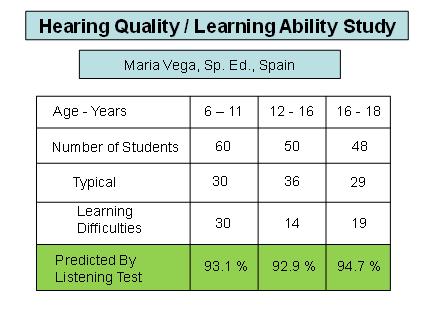청각과 학습능력과의 상관관계 연구
(Study on the Correlation between
Hearing Quality and Learning Ability)
연구자: 스페인의 베라르AIT 치료사(특수교육자), Mrs. M. Vega
베라르 박사는 수천명의 학생들을 연구한 후에, 학습장애 학생은 청각의 질적인 문제 때문에 구어학습에 주의를 기울일 수 없고, 쉽게 이해할 수도 없다는 것을 밝혔습니다. 반면에 학업이 우수한 학생들은 청각 이상이 없다는 것을 밝혀냈습니다. 이 연구의 목적은 이러한 베라르 박사의 주장을 검증하기 위한 것입니다.
연구내용
Mrs. M. Vega는 스페인의 마드리드의 2개 학교를 대상으로 2000 ~ 2001년에 걸쳐서 청각과 학습능력과의 상관관계를 검증하기 위한 연구를 수행했습니다.
연구가설
“학업수행에 대한 청각의 영향은 매우 커서 청각결함으로 학습장애 확인이 가능하다”
연구설계
연구자는 학생들에 대한 사전 지식이 없었다: 연령, 학년, 학업성적을 모르는 상태에서 연구가 시작되었다.
청각검사는 학생들에 대한 어떠한 사전정보도 없이 수행되었다. 제 3자의 입회하에 청각검사가 실시되었고, 학생들에게는 코드번호가 부여되었고, 연구자는 청각검사의 결과를 분석할 때 코드번호(익명으로)로 처리하였다.
연구자는 연구수행은 허용되었으나, 연구대상 선택은 교사들의 준거에 따라 교사들이 하였다. 학생들을 연령(학년)에 따라 3개 집단으로 분류하고, 다시 각 집단을 일반학생 집단과 학습문제 학생 집단으로 분류하여 구성하였다. 학생들은 청각검사 방식에 관해서 교사의 지시를 따랐고, 연구자가 학생들에게 어떠한 설명도 할 필요가 없었다.
연구방법
청각검사는 11개주파수 에 대한 예민도, 반응 타이밍, 편측성, 피치변별을 측정하는 검사를 하였다. 청각검사 후, 청각 결함 유무에 따라 2집단으로 분류하였다.
이 연구에서 베라르박사의 주장(이 연구의 가설)이 입증된다면, 청각의 질적 결함이 있는 학생은 학습장애를 가지게 될 것입니다.
마지막에 이 연구결론을 학생들의 실제 학업수행(학교성적, 교사증언)과 비교하였습니다. 청각검사 결과로 학업수행력 예측력이 90%이상으로 나타났습니다.
청각/ 학습능력 연구
(Maria Vega, Sp. Ed., Spain)
|
연령-학년
|
6-11
|
12-16
|
16-18
|
|
학생 수
|
60
|
50
|
48
|
|
일반학생
|
30
|
36
|
29
|
|
학습문제 학생
|
30
|
14
|
19
|
|
청각검사 예측력
|
93.1 %
|
92.9 %
|
94.7 %
|
베라르박사의 가설의 입증
연구자는 이 연구의 3개 집단에서 베라르박사 가설이 입증하였으며, 전반적 결론은 청각적 질은 학급활동에 매우 중요해서, 학업성공과 실패는 청각의 수준에 달려있다. 학생의 성적이 일관성 있게 저조하다면, 학생의 청각적 질이 나쁘다고 추측할 수 있다. 청각검사에서 학생의 청각에 결함이 있다면 그 학생의 성적은 상위권이 아닐 가능성이 매우 높다.
* 이 연구 결과는 학업성공과 실패는 청각의 질적 상태에 달려있다는 것을 시사하고 있습니다.
원문보기↓
Study on the Correlation between
Hearing Quality and Learning Ability
Study by Mrs. Maria Vega, Berard AIT practitioner, Special Educator
and Co-Founder of Vegakids Instituto DesarrolloInfantil,Madrid,Spain
Translated by Victor Estalayo, Berard AIT instructor/Practitioner
Introduction
After studying thousands of students, doctor Bérard found out that those with learning disabilities cannot pay attention to,nor understand easily oral lessons due to the poorquality of their hearing, while those who are smart at school have no hearing anomalies.
Study
In the school year 2000-2001 a study was conducted by Mrs. M. Vega, practitioner of Dr. Berard’s AIT method in Madrid(Spain),in two schools with the purpose to verify this hypothesis:
“The influence of a student’s hearing quality on school performance is so great that it is possible to identify those with learning disabilities just by their hearing quality deficiencies”.
Study Design
1. Reliability
The researcher would have no previous knowledge of the subjects: she would even ignore their age and grade, an, of course their school performance.
She would test the hearing quality of the subjects without retrieving any further information from them and always in the presence of a third person who could witness that it was so that she proceeded in that manner. Eventually students would be identified by a code number, so that the researcher could treat the subjects anonymously when analysing the results of the hearing test.
The researcher was allowed to conduct her study but the selection of subjects was made by the teachers according to their own criteria. They selected three different groups of subjects. Refer to Figure 1 below for the composition of these groups. The subjects would be instructed by their teachers on how to do the audio test. By doing so, there was no need for the researcher to explain anything to them, preventing any insight on their intelligence from eventual answers or comments.
2. Methodology
2.1. The researcher would test both how much and how well each student could hear. The audio test would let her know hearing keenness in eleven sound frequencies, as well as response timing, laterality and selectivity.
2.2. Audio testing results would be used to classify subjects in two different groups according to the presence or absence of deficiencies in hearing quality.
2.3. If Berard’s hypothesis is verified by this study, those with deficiencies in their hearing quality would have learning disabilities.
2.4. The researcher’s conclusions would eventually be compared with the actual learning performance of each subject as testified by the school records and staff.

Verification of Dr. Berard's Hypothesis
The researcher considered Dr. Berard’s hypothesis verified in the three groups under study and her overall conclusion is that hearing quality (hearing intelligence) is so important for classroom activity that learning success and failure depend on its level. If a student’s grades are consistently low, you can guess that her/his hearing quality is poor. If an audio test shows that a child has a deficient hearing intelligence, most probably she/he is not among the top students.









